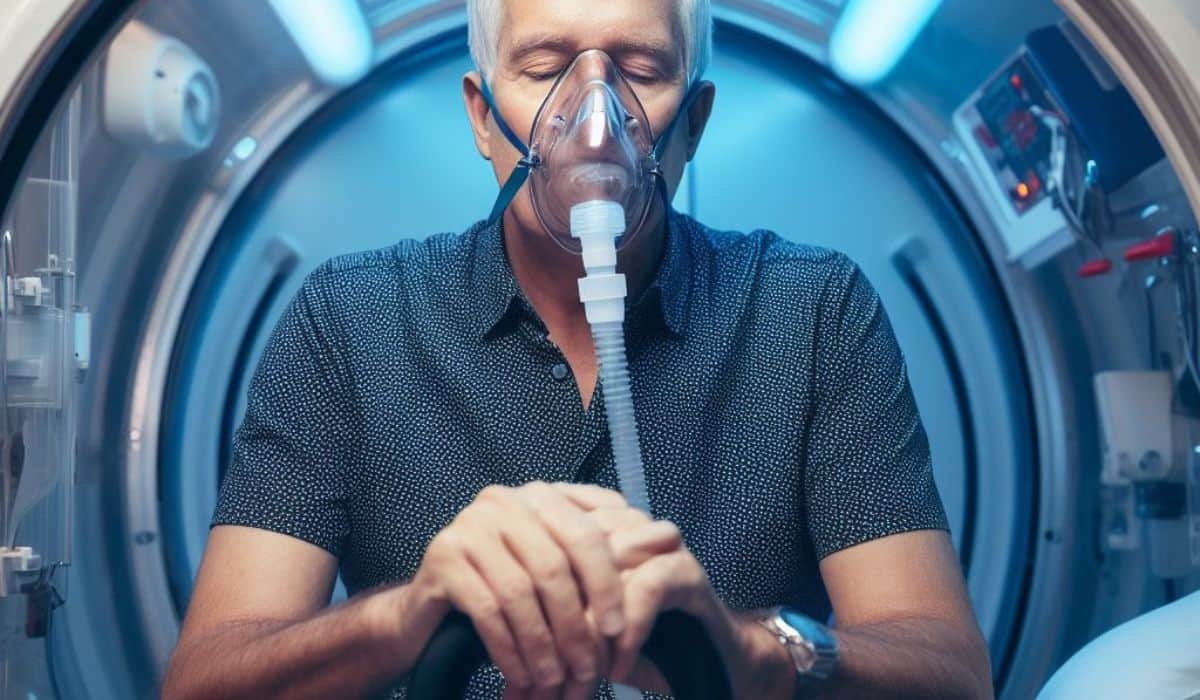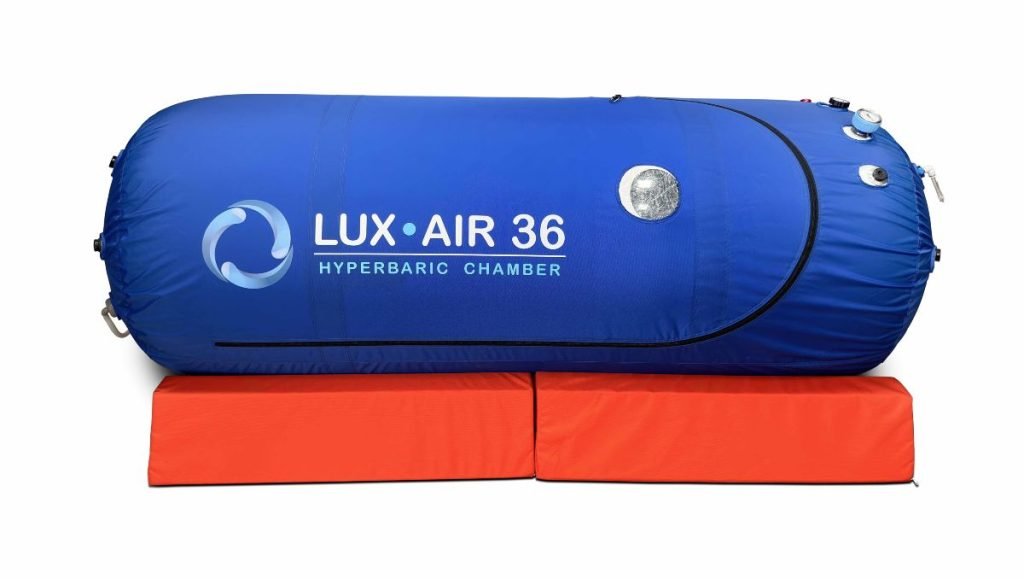Is Hyperbaric Oxygen Therapy Useful for Parkinson’s Disease?

Do you know someone with Parkinson’s disease? Are you looking for an effective treatment option? Hyperbaric Oxygen Therapy (HBOT) may be an alternative Parkinson’s treatment worth considering.
In this article, you will learn more about how HBOT works, what the science says about it, and what other alternative treatments are available.
We will also briefly discuss if insurance covers HBOT for Parkinson’s disease, how to access this treatment as well as answering any related questions associated with Hyperbaric Oxygen Therapy and Parkinson’s disease.
What is Parkinson’s disease and why it occurs?
Often, people aren’t aware of what causes Parkinson’s disease and how it affects their lives.
Parkinson’s disease is a progressive neurological disorder characterized by a decrease in the amount of dopamine produced in the brain. [1]
This decrease leads to a variety of movement-related symptoms, such as tremors, rigidity, impaired balance, and slowed gait. It can also cause non-motor symptoms, including fatigue, depression, sleep disturbances, and cognitive decline.
The precise cause of Parkinson’s disease is still unknown, however, environmental and genetic factors may be involved.
Studies have suggested that exposure to toxins, for example pesticides, could increase the risk of developing Parkinson’s disease. [2]
Similarly, there’s evidence that genetic mutations can also increase the risk of developing the condition. [3]
The effects of Parkinson’s disease on an individual’s life can be severe. It can cause significant physical and emotional distress, and can limit a person’s ability to carry out daily activities.
In some cases, it can even lead to disability. Fortunately, there are treatments available that can help to manage the symptoms of Parkinson’s disease and one promising one is Hyperbaric Oxygen Therapy.
What are Parkinson’s disease main symptoms?
The main symptoms of Parkinson’s disease are often characterized by motor and non-motor problems.
Motor symptoms include:
- tremors (most common)
- muscle rigidity
- difficulty with coordination.
Non-motor symptoms include:
- depression
- difficulty sleeping
- anxiety
- changes in cognitive functioning.
As the disease progresses, individuals may experience problems with balance, difficulty with speech and swallowing, and an increased risk of falls. There’s also an increase in fatigue and an overall decline in physical health.

The impact of Parkinson’s disease can be far-reaching.
The condition can significantly reduce an individual’s quality of life and cause a great deal of disruption to their daily routine. It’s important for those affected to be aware of the signs and symptoms of the condition, and to seek medical advice if they’re concerned.
With the right treatment and care, individuals with Parkinson’s disease can still lead active and fulfilling lives.
What is Hyperbaric Oxygen Therapy and how it works?
You may have heard of hyperbaric oxygen therapy, but do you know how it works?
Hyperbaric oxygen therapy (HBOT) is a medical treatment that involves breathing pure oxygen inside a pressurized chamber. HBOT is thought to be beneficial for a range of medical conditions, including Parkinson’s disease.

Here’s how it works:
- Raises oxygen levels in the blood
- Enhances the body’s natural healing processes
- Stimulates the release of substances that promote healing
In HBOT chambers:
- Patients breathe 100 percent oxygen
- Pressure is increased to 2-3 times normal atmospheric pressure
- Treatment usually lasts for 90 minutes

HBOT has been used to treat a variety of medical conditions, including Parkinson’s disease. It has proven beneficial to many other conditions. If you want to learn more about what condition Hyperbaric Oxygen Therapy may or may not treat, check our HBOT resources page.
How Hyperbaric Oxygen Therapy (HBOT) can help with Parkinson’s disease?
HBOT can help alleviate the symptoms of Parkinson’s disease by increasing oxygen delivery to tissues and promoting neuroplasticity.
This treatment involves lying in a pressurized chamber for 90-120 minutes a day, with 20 sessions recommended for new patients. This pressurized environment mimics diving to depths of 33-45 feet, allowing up to 10-20 times more oxygen to be dissolved in the blood plasma.
HBOT increases oxygen supply and tissue oxygen partial pressure, reduces cerebral swelling, improves tissue healing, and boosts metabolism.
It also increases cell-protecting enzymes and helps prevent brain damage.
By modifying brain activity patterns, HBOT can reduce depression, anxiety, and tremors in patients. It’s thought to treat Parkinson’s by increasing oxidative metabolism in dopaminergic neurons, and provide relief for neuropathy by preventing cell death and relieving pain.
Additionally, HBOT encourages the development of new blood vessels, increasing oxygen and nutrition supply to tissues.
With this treatment, the brain’s capacity for change and rewiring of neural networks is increased, ensuring a better neurological outcome.
What Scientific Research Says?
Although there’s limited research available on the use of Hyperbaric Oxygen Therapy (HBOT) for treating Parkinson’s disease, studies have shown promising results.
Here is an overview of what scientific research has uncovered:
HBOT Potential for Parkinson’s Treatment
An article published in the journal, Biomolecules, looked into whether hyperbaric oxygen therapy (HBOT) could help people with Parkinson’s disease (PD). In a PD mouse model, HBOT increased the number of important brain cells, improved factors that support brain health, reduced cell damage, and lowered brain inflammation.
It also made the mice move better. In lab tests, HBOT helped protect brain cells from damage. This might be because HBOT boosts the creation of energy-producing structures in cells, which helps protect brain cells and improve movement in PD.
These findings suggest that HBOT could be a useful additional treatment for Parkinson’s disease.
Combination Therapy for Parkinson’s Dementia
In a study, 122 Parkinson’s disease dementia (PDD) patients were divided into two groups: one receiving only donepezil and the other receiving donepezil, hyperbaric oxygen therapy, and functional rehabilitation training.
Both groups also had standard symptomatic treatment. The group with combined treatment showed better results, with higher effectiveness and significant improvements in cognitive function, self-care ability, and quality of life.
Additionally, the combined treatment reduced serum interleukin-1β and interleukin-6 levels, suggesting a potential mechanism for its therapeutic benefits in PDD patients.
Hyperbaric Oxygen Therapy for PD Depression
In another case report published in the journal Medicine (Baltimore), a patient with Parkinson’s disease (PD) and severe depression and anxiety was treated with hyperbaric oxygen therapy for 30 days.
This treatment led to significant improvements in clinical assessment scores for depression and anxiety, as measured by various rating scales. The patient had initially refused common treatments for psychiatric symptoms in PD.
These findings suggest that hyperbaric oxygen therapy could be a promising option for managing depression and anxiety in PD patients who may not respond to standard treatments.
HBO for Parkinson’s: Case Study
In a case study, a 72-year-old male with Parkinson’s Disease (PD) received hyperbaric oxygen therapy (HBO) alongside standard PD medications.
Prior to HBO, he was on Sinemet for PD and other medications for coronary artery issues.
Sinemet is a medication that contains two active ingredients: carbidopa and levodopa. It is used to treat Parkinson’s disease and some forms of parkinsonism. Carbidopa and levodopa work together to increase the levels of dopamine, a chemical that is lacking in the brain of people with these disorders.
After 25 sessions of HBO, the patient gradually reduced his Sinemet dosage and eventually stopped taking it, an unexpected outcome.
While voice and speech changes were minimal, hand function improved significantly, particularly in the non-dominant hand.
The patient tolerated HBO well without adverse effects.
This case suggests that HBO therapy may offer potential benefits as an adjunct treatment for PD, including reducing the need for certain medications.
Hyperbaric Oxygen Therapy in Neurological Conditions
Another article published in the journal Neuropsychology Review discussed the use of hyperbaric oxygen therapy (HBOT) in various neurological conditions.
The review analyzed 42 studies but found mixed results on the effectiveness of HBOT. It emphasized the need for more precise assessment methods and broader evaluation of HBOT’s impact on different cognitive functions.
The review also calls for future long-term studies to provide a clearer understanding of HBOT’s potential in treating neuropsychological deficits.
How does Hyperbaric Oxygen Treatment Compares To Other Alternative Parkinson’s Disease Treatments?
Now, before you read further, It’s important to remember that none of these treatments can cure Parkinson’s, but they can help manage symptoms and improve quality of life.
Hyperbaric Oxygen Treatment (HBOT) is backed by actual research – as we’ve seen above – for its effectiveness in treating Parkinson’s disease. It’s a safe, non-invasive option that involves exposing the patient to high-pressure oxygen in a chamber.
It can be used in conjunction with other alternative treatments like yoga, massage, acupuncture, music therapy, art therapy, CBD Oils and Herbs.
While each of these treatments have their own benefits, HBOT can offer a unique approach to helping manage the symptoms of Parkinson’s.
Again, it’s important to be aware of any practitioners claiming to ‘cure’ Parkinson’s disease or advising abrupt medication changes without consulting with a healthcare professional.
Ultimately, HBOT and other alternative treatments can help treat the symptoms of Parkinson’s, but not cure the disease.
How to Access Oxygen Hyperbaric Treatment for Parkinson’s Disease?
If you have been considering Hyperbaric Oxygen Treatment (HBOT) for treating your Parkinson’s Disease, you’ll need to figure out how to access it.
The main options available are visiting a medical center or buying an HBOT chamber for home use:
Visiting a medical center:
Medical centers around the world are beginning to offer HBOT services, but it can be costly. Most centers charge up to $200 per session, and your insurance may not cover these expenses. You’ll still need to drive to the medical center, which can be inconvenient.
If you consider that you or your loved one should do 1 session per day then you can understand that after just 40 sessions you’ll end up paying around $4.000 – $8.000.
Buying an HBOT chamber for home use:
Buying an HBOT chamber for home use, can cost between $8.000 to $20000, but you’ll make your investment back in less than two months if used regularly. If your other family members want to use it – to benefit their health – you will make your investment back in less than a month.
On top of that, if you decide that you want to ger rid of the chamber, you can resell it on the second-market and get at least half your money back.
If you don’t have the money to buy a Hyperbaric Oxygen Therapy Chamber for home use, keep in mind that online vendors offer financing options, and you can pay for the HBOT chamber in installments. This is a great way to access HBOT if you don’t have the resources to buy one outright.
To start with, I suggest you check our articles where we suggest different models of Hyperbaric Chambers:
- Top 7 Affordable Hyperbaric Chambers of 2023 Suitable for Home Use
- Where to Buy Used Hyperbaric Oxygen Chambers for Sale?
- 7 Best Hyperbaric chambers for home use
Does Insurance Cover Oxygen Hyperbaric Treatment for Parkinson’s disease?
Does your insurance cover hyperbaric oxygen therapy for Parkinson’s disease?
It depends on your plan and the medical condition.
Most insurance companies require prior authorization for HBOT treatments, and the amount you’ll have to pay out-of-pocket will vary.
Medicare, Medicaid, and many other insurance companies typically cover HBOT for certain conditions, but it’s best to check with your provider first. In some cases, they may not cover the cost.
Frequently Asked Questions
Final Take
Hyperbaric oxygen therapy (HBOT) has been demonstrated to reduce certain symptoms associated with Parkinson’s disease.
Yet, further research is necessary to determine its effectiveness and safety for treating the condition.
While HBOT may provide a potential option for those looking to supplement traditional Parkinson’s treatments, it’s important to discuss it with your doctor and research your insurance coverage before pursuing it.
More Articles on Hyperbaric Oxygen Therapy
